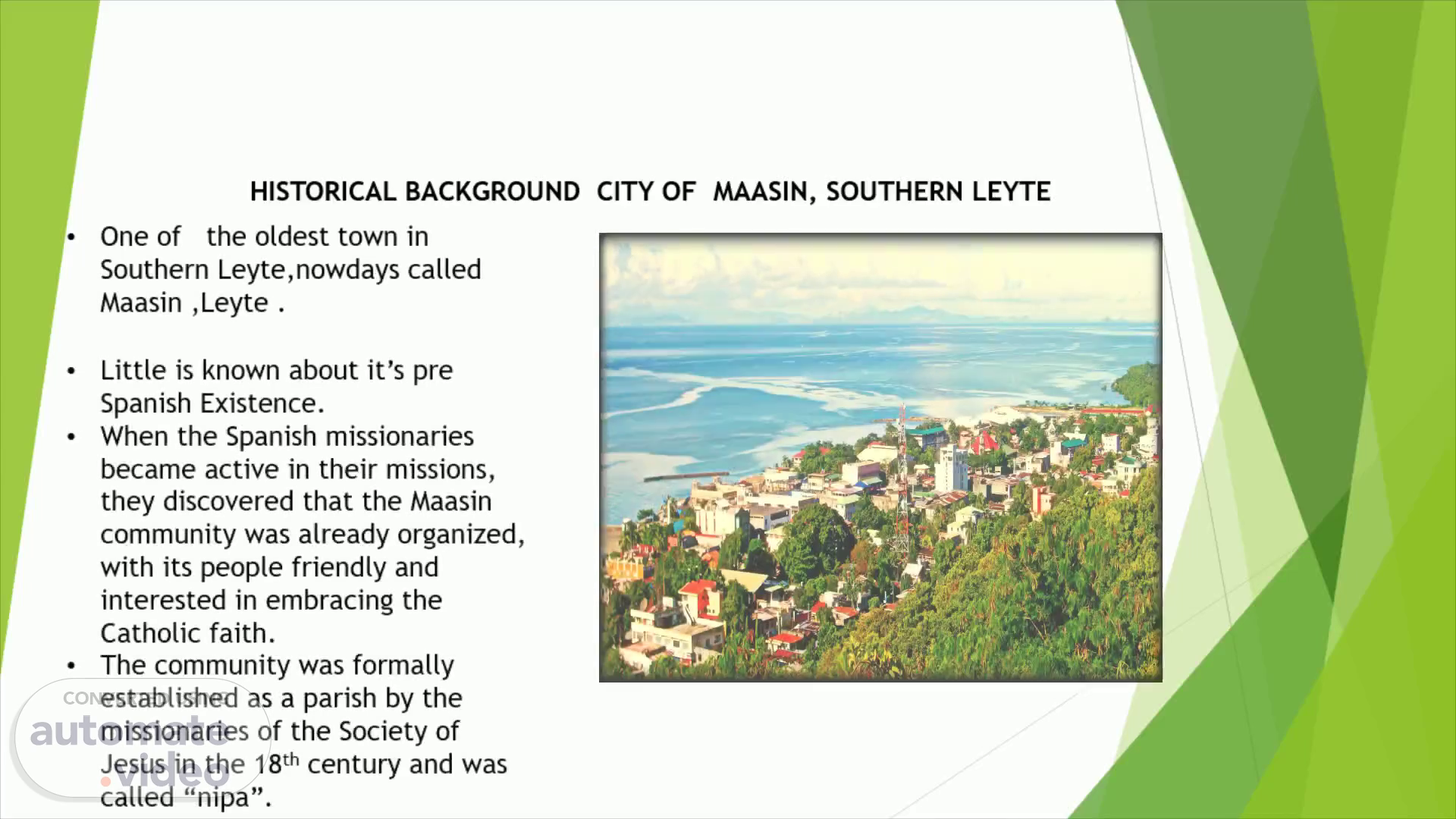
HISTORICAL BACKGROUND CITY OF MAASIN, SOUTHERN LEYTE
Scene 1 (0s)
HISTORICAL BACKGROUND CITY OF MAASIN, SOUTHERN LEYTE.
Scene 2 (23s)
The town grew rapidly in the 18 th century after the Jesuit priests built the first church of which ruins still exists today between the two districts of Abgao and Mantahan. The Jesuit administration prevailed from 1700 through 1768. Subsequently, Augustinian fathers took over the parish from 1768 to 1843 during which the townspeople, with the guidance of the Spanish ecclesiastical authorities, built the town’s second concrete church located approximately one kilometer away from the ruins of the first one..
Scene 3 (46s)
The arrival of the Americans at the beginning of the 20 th century and the suppression of all resistance to the American rule stopped all dreams of Philippine independence. True to their word, the Americans instituted in this country their democratic institutions. Maasin was one of the beneficiaries of this enlightened American policy. Schools were established; businesses began to uprise and prosper; and, Maasin became the most progressive town in southwestern Leyte (and still is)..
Scene 4 (1m 8s)
Population/ Language/ Area. With the recent census, the city reached a total population of 81,737 with the people speaking Cebuano and Boholano as their native language. The province has a total land area of approximately 173,480 hectares characterized by flat lands along the coastal areas and mountainous towards the interior. Additionally, the land has numerous small and major rivers..
Scene 5 (1m 28s)
Business Opportunity The city offers opportunities in food processing especially fruit, vegetables, meat and fish processing. The manufacture of furniture, clothing and fashion accessories, jewelry, personal care and other consumer goods are encouraged. The establishment of commercial complexes and tourist facilities are welcomed in this city..
Scene 6 (2m 30s)
Tourist Spot. Maasin Cathedral this church was built in the 1 7th century. This is probably not only the biggest but also the oldest church in Maasin City. It is a diocesan seat since 1968. It shares its history with Don Anatalio Gaviola Plaza which is dedicated to a former mayor of Maasin. It is still one of the highly recommended stumping points for tourists as well as for locals..
Scene 7 (3m 35s)
The Guinsohotan Cave Is a large subterranean cave, 15 km from the city center and 276 meters above sea level. Those who enter the cave by wadding or swimming can find small “in-cave” waterfalls, bats, and impressive rock formations. The water coming out of Guinsuhotan Cave flows down in cascades forming a natural lagoon..
Scene 8 (3m 52s)
Abiera Museo d’Art Shows rare collections of artifacts, antiques, paintings, preserved animals, coins, gems, and other historical relics. Although it is privately owned by the Abiera Family, it can be visited by interested ones. It is located at Barangay Tunga-tunga in the heart of the city..
Scene 9 (4m 9s)
Monte Cueva Maasin shrine is a place that is well-known for the Marian devotees. Situated at Monte Cueva Asuncion de la Virgen Shrine, or simply Monte Cueva, this place has been a must-see place for the devotees and the pilgrims..
Scene 10 (4m 24s)
Our Lady of Assumption The Our Lady of Assumption’s image stood 36 ft. Conquer more than 300 steps and ascends towards the shrine that is 310 ft. above sea level and located at Barangay Mantahan. Our Lady wears the colours white and blue signifying her purity, royalty and following God’s Commandments. PETERE,NOE O . 4 th year BS CRIM SECTION:M Comptype 2.